#is anyone else a victim of the gloria scott part 2 because i have not been normal since it dropped.
Text
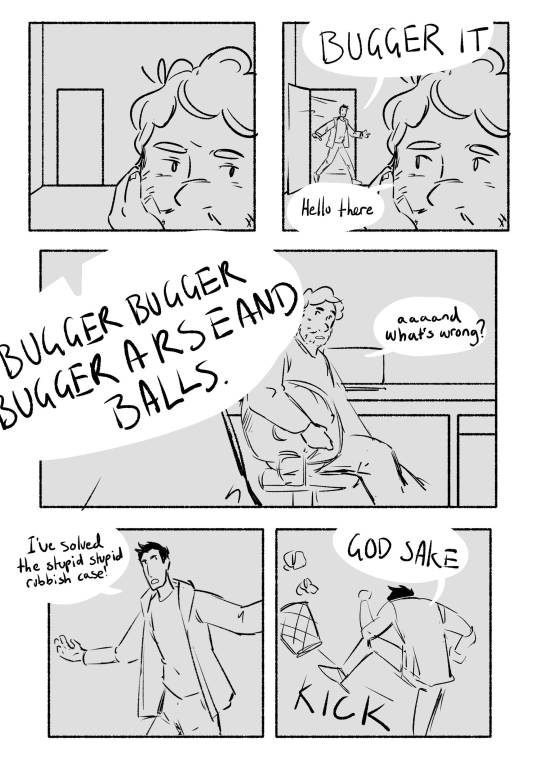

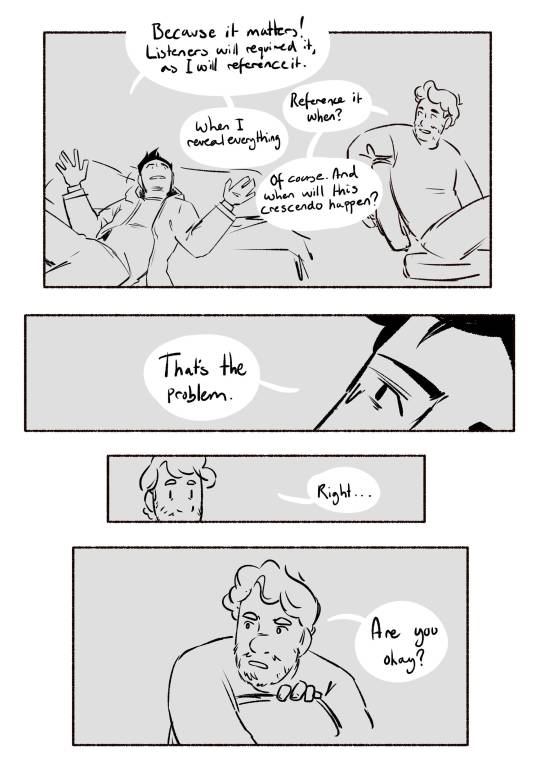
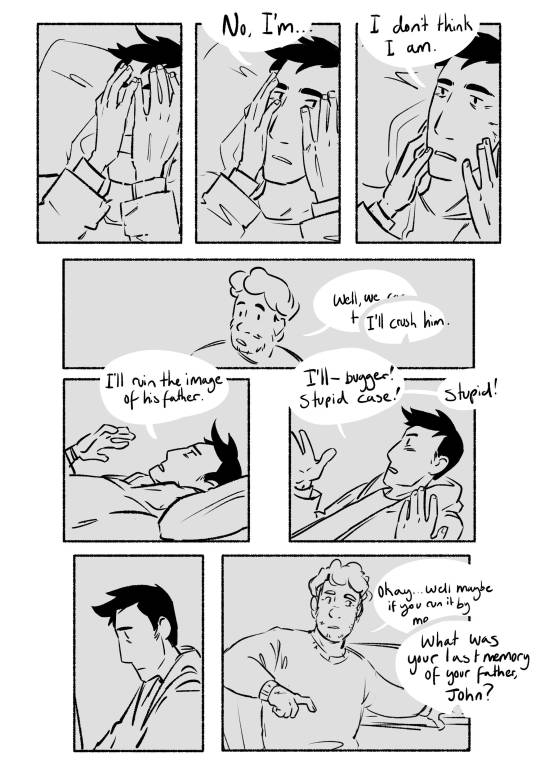
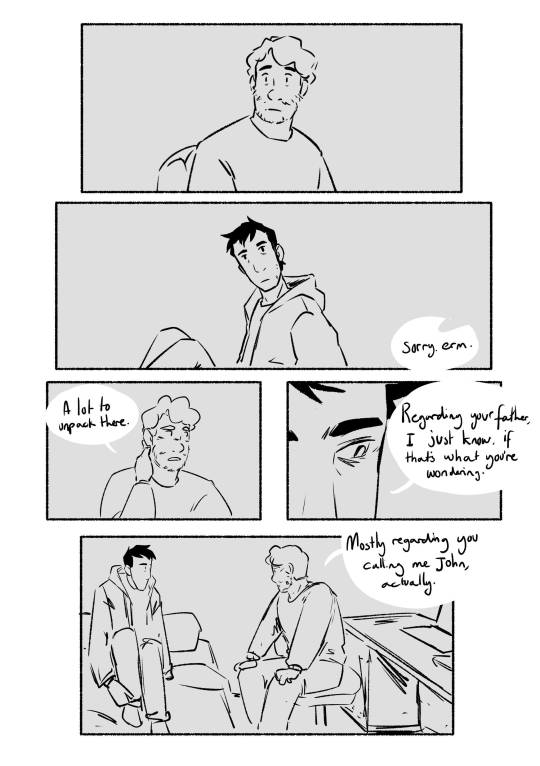
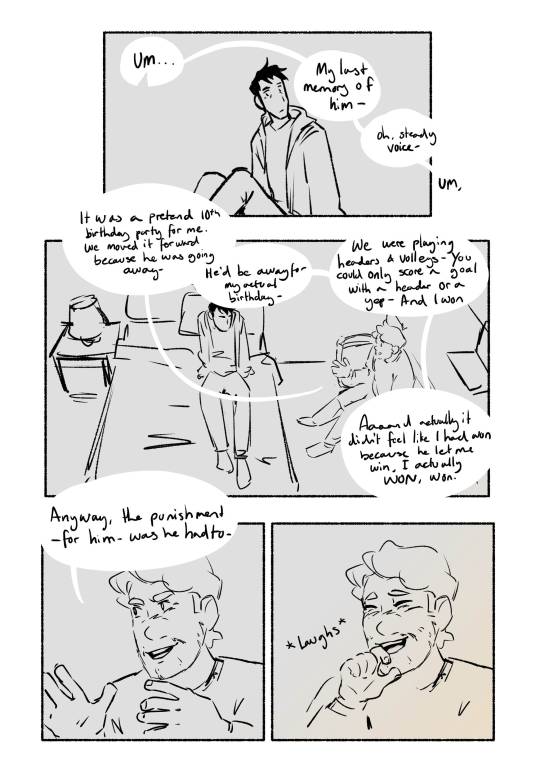
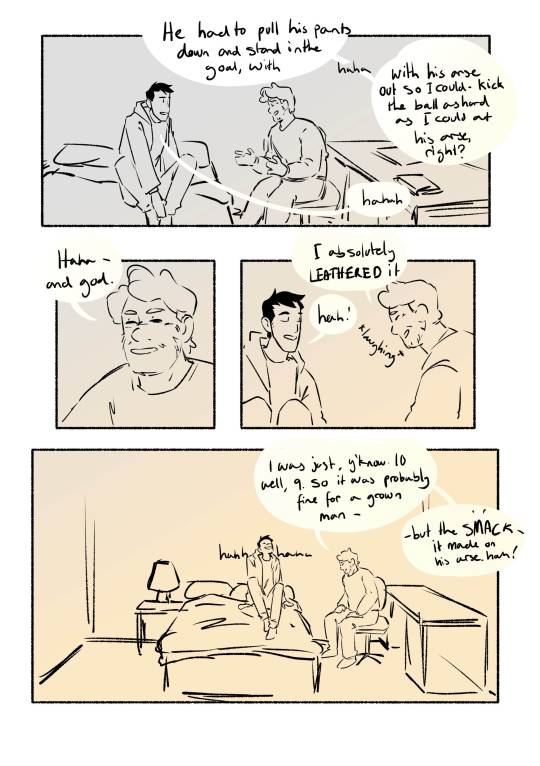
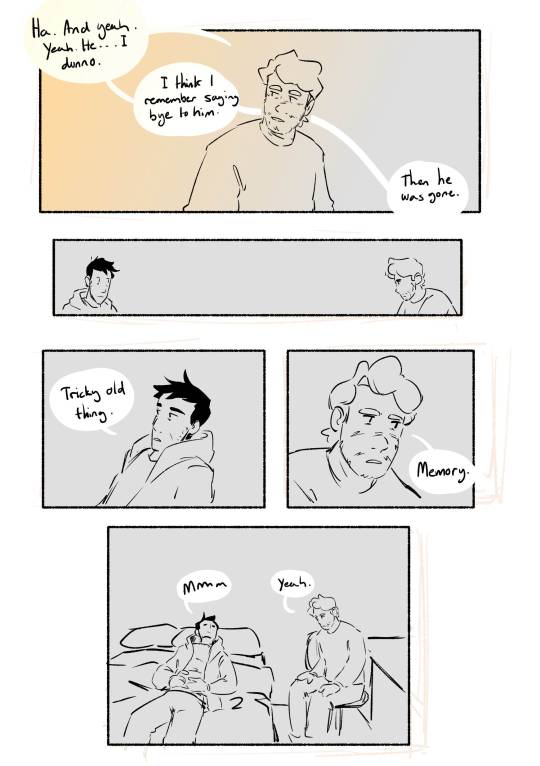
little comic based on The Gloria Scott - part 2
#sherlock & co#sherlock and co#is anyone else a victim of the gloria scott part 2 because i have not been normal since it dropped.#this scene rly stuck with me. and i know other people feel the same.#also does anyone else think sherlock laughs on purpose?#remembering in an early ep when john says he 'wouldve prefered a laugh' when sherlock just says 'funny'.#not like its forced laughter. i think he just makes an effort to actually laugh when he thinks something is funny. ive overthought this#joel when i GET YOU.#anyway sorry for sherlockposting in 2024#sherlock & co spoilers#patsart
1K notes
·
View notes
Text
Sherlock Season 4 Trance Theory (Part 2)
In part 1 of trance theory, I proposed that Sherlock put himself in a deep meditative trance in order to solve the return of Jim Moriarty.
In part 2, I'd like to provide further evidence that trance theory explains what is happening in S4; including the repeated dialogue, the apparent POV changes, and the impression of the 4th wall being broken,
But first, I'd like to discuss how a trance helps Sherlock Holmes solve a difficult case.
Sherlock Holmes has the amazing ability to make great amount of observations at great speed. He then processes the information he has gathered to make a logical conclusion.
But sometimes, just like we saw in TSoT, Sherlock can make a deduction before he has consciously processed the data. His brain works so fast that he doesn't even realize exactly what he has observed and he has already reached a conclusion before the chain of deductive reasoning can catch up. Remember how in TSoT he keeps reaching conclusions before the evidence is even processed? "That was one more deduction than I was expecting."
So, we know that Sherlock collects data without even consciously doing so. Sherlock knows this. It's part of his gift. And he uses the fact that he has these vast amounts of micro-observations floating around in his subconscious to solve cases. This is why he meditates when faced with a difficult case.
In a trance, Sherlock is exposed to what is important before his consciousness catches up. He can retrieve clues related to a case he wasn't even aware of having gathered.
A trance allows Sherlock to tap into unconscious reasoning... this is when the art of deduction blends in with the science of intuition.
How Trance Theory explains repeated dialogue /repeated events
Once Sherlock is in a deep trance, all the important tidbits related to a case 'rise to the surface' if you will. Sherlock's subconscious knows these are important clues related to the case and he tries to connect the dots. Sherlock then fills in the gaps with things/events/dialogues/that has been used in the past in order to connect the dots in a way that makes sense.
It's like his memories and past events provide the scaffolding for the unconscious clues. It's a bit like when you're reading a text and you guesstimate the meaning of the words you don't know by the gist of what is being said in the rest of the text. Except in this case, Sherlock has a bunch of unprocessed observations he has gathered and to make sense of them, he places them in situations that have really happened to "set the stage" to eventually decipher the meaning of those unconscious clues.
In other words, Sherlock has all these discrete observations he unconsciously knows are important to the case and he ties them together with things he's seen or heard in the past. He "fabricates" a story with the clues that shimmer at the surface of consciousness.
And because a trance is not controlled logical reasoning, a sort of free association occurs and other events and memories appear in his trance.
In the case of Moriarty's return, Sherlock instinctively knows that it's related to "ghosts' from his past. He knows he has to go deep within himself and access any micro-observation he's made since he was little in order to solve this case.
Plus, we know that his memories have been tempered with, but the brilliant detective still manages to retrieve clues that are buried deep within himself since a young age. (I am so in awe of his brain!)
And this is how being in a trance helps Sherlock solve cases. The more difficult the case the longer the trance. (And yes, just like in ACD, it seems Sherlock also uses drugs to heighten the trance process.)
I'd like to give a few examples of Sherlock tapping into his past and using observations/images/dialogue he unconsciously stored in his head to help him connect the dots later when he is "awake". At this point, I won't get into the possible deductions Sherlock can draw from these unconscious clues. I just want to illustrate the process of how his mind works in a trance and how it ties in with ACD canon.
Example #1: In T6T, a client has a tattoo with the Japanese name Akako that he has tried to obliterate on the inside of the crook of his arm. The meaning of the Japanese name in English is "red child".
In ACD's story The Gloria Scott, Victor Trevor's father also had secret tattoo of a name in the inside crook of his arm he tried to obliterate. The name turns out to be Mr Trevor's real name before he changed his identity.
Now if you connect the two together, you'll remember that Victor Trevor was "Redbeard" (because of his red hair?) and that the entire Redbeard incident had been obliterated from Sherlock's memories.
Please note; I'm not saying Victor Trevor's dad tried to obliterate his son at the Holmes family home. I'm trying to illustrate the point that these clues are in Sherlock's subconscious and they are still all tangled together. :D
To make my point, let's go back to the client with the tattoo in T6T. We also know that the client enjoys cross-dressing. We know from HLV that uncle Rudy also likes to cross-dress. The root of the name Rudy is also "Red."
Let's keep going; We know from viewing TEH that Mary has a secret tattoo . We also know that Mary used to be a super-spy in her past life... just like the client's ex-wife.
See how it's all interconnected, yet all tangled and dramatized?
Example #2: In T6T, we see in Sherlock’s subconscious a random shelf with one of Carl Power's shoe on it.(Yes, it’s Carl’s shoe. If you enlarge it and compare it you’ll see the same patterns on the back of the shoe. See photo below.)

Sherlock's subconscious tells him that Moriarty's return is all tangled up with where Moriarty started as well.
And once you've pulled on that particular thread, you can make other links with it. For example in TFP Eurus tells Sherlock that Redbeard was his very first case, but in TGG Sherlock tells John his very first case was the drowning of Carl Powers. It's all cleverly interconnected. Everything is a clue. Remember this exchange between John and Sherlock in T6T?:
John: "You can't arrest a jellyfish!"
Sherlock: "Well, you can try."
John: "We did try."
Well, in ACD canon there is a story (The Lion's Mane) where-- in the end--Holmes deduces that the jellyfish is the murderer and was the one who paralyzed the victim in the pool of water. The interesting part of the story is how one of the suspects (not the jellyfish!) had previously abused the victim's dog. Later, the dog was also found dead, paralyzed and drowned. See the parallels between both the Carl Powers case, the missing Redbeard case, and canon?
This also ties in with the song Eurus gave young Sherlock in TFP in order to solve the Musgrave ritual and save Redbeard. I won't explain it here because it leads to another set of clues linking everything to Thatcher, sharks, Culverton Smith, dark secrets, Moriarty's posthumous game, and ultimately, John and Sherlock's touching love story.
Seriously, I could go on and on (ask anyone in my household) but I really need to convince you that Sherlock is indeed in a trance before I do that.
Consequently, the next part of this meta provides more evidence that Trance Theory explains other oddities in S4.
Trance theory and different points of view
Some scenes in S4 seem to be from John's POV and as result different theories have evolved around that fact; ie. John has been drugged with TD12, John is in a coma, or John has a mind palace too. `Some of these theories explain a facet of what we've seen but not everything.
First, we know the effect of TD12 doesn't last long and only tempers with memories. It doesn't create or sustain vivid dream-like states. (Note; I'm not saying that TD12 is not important. It's a major clue for something else, but it's not what's causing the 'oddness' of S4). The theory that John is in a coma doesn't explain how he and Sherlock would both be sharing the same vivid like-dreams at one point or another. Also, as far as I know, a coma has never been a plot thread in any of the ACD canon stories. And finally, we have never seen John using a mind palace to retrieve information. And as I said in part 1, a mind palace cannot create vivid dreams.
Therefore, I maintain that Sherlock is in a deep meditative trance and everything we see is from his POV for the entirety of S4 (and TAB). He is also trying to solve a case and he has the ability to create extensive scenarios to connect clues when he's in a trance.
So, why do some scenes appear to be from John's POV?
The fact that Sherlock can use "images" or "scenes" from when he wasn't even there to witness the event can be explained in 2 different ways.
1) Sherlock deduced John's POV: someone with Sherlock's capacity to remember details, it's easy for him to imagine what that scene would've looked liked even if he didn't witness it. Also, Sherlock likes to see himself through John's eyes. In TAB, Sherlock was able to re-create John's POV while at war in a different time period simply by reading John's blog. So if he can do that, then he can create other scenarios as well.
OR
2) Sherlock simply viewed CCTV footage/hidden cameras and that is why he is able access John’s POV.
Trance Theory and Breaking the Fourth Wall.
There are several incidents whereby Sherlock or John seem to look directly into the camera as if making eye contact with the viewers (ie. breaking the 4th wall).
I don't believe the fourth wall is broken. Sherlock is in a deep meditative trance and any scene where he (or John) seem to be looking directly into the camera are actually scenes where Sherlock is spotting hidden cameras.
There is enough evidence throughout all 4 series that 221B and other places have hidden spy cameras (conveniently called black pearls) in different locations. We know Moriarty placed one in 221B. Mycroft probably has them all over the place. Sherlock's mind also tells us that he's used them in the past just like he used a recording device in TLD.
This is a neat way of transporting ACD canon into the modern era. There are several ACD stories where spying is involved. Holmes hides behind a curtain in at least 3 stories, Watson hides under a bed, Holmes creates a dummy and hides elsewhere. The essence is the same as a hidden camera; it's a hidden pair of eyes.
So the famous one where John seemingly breaks the 4th wall in T6T?

This is not John looking at us but John looking at a hidden camera in the flat and raising his glass to Sherlock.
There are obvious clues that John and Sherlock have been working together since HLV (the long missing scene between the domestic in 221B and the apparent forgiveness scene at Christmas.) I am not surprised that they have a hidden camera in John's flat.(I assume this must have happened at one point between HVL and the Tarmac scene).
The other scenes where we see Sherlock looking directly at the camera are just different places where Sherlock is deducing there are hidden cameras. Remember this is all in Sherlock's subconscious and what Sherlock is experiencing are actually clues.
There is also an element of mind control I'd like to discuss as farther proof; but I've decided it needs its own meta because it exposes a huge plot twist and again, you need to believe that Sherlock is in trance in order to untangle it all.
Trance Theory and accepting S4 at face value
I have read different metas from good friends arguing that S4 must be taken at face value and that all the inconsistencies are part of TV storytelling and that the viewers must exercise a certain amount of "suspension of disbelief". I agree with that statement (I'm a biochemist by training and I can tell you, you can't identify chemical compounds using a microscope as Sherlock did in TRF. But It doesn't bother me one bit. It's how TV works. So, yes, of course, suspension of disbelief is required.)
In the case of Season 4, I agree that you might be able to explain the physical impossibilities--ie. John magically being unchained in the well or Sherlock being telleported off a secluded island to a fake room in the middle of nowhere--as being normal elements of suspension of disbelief. That's fair enough.
But, to me, the repeated dialogue does not fit in with that reasoning. The writers did not need to cut corners with the script. They are creative enough to come up with new material for S4.
If you take S4 at face value, I believe you need to accept the oddities for what they are: clues. Putting it under the umbrella of suspension of disbelief doesn't work because there's no need for the writers to recreate the same scenes and the same dialogue, or even use the same episode title that they already used in John's blog.
Note: Trance Theory actually explains how it's possible that The Six Thatcher title was repeated for both the blog and S4E1 because Sherlock used a case he had already solved as a template in his subconscious.
Also, if s4 is to be taken at face value, it doesn't reflect the story they have been telling from the beginning. It merely gives the illusion of tying up loose ends (but it does not). Did we ever find out the connection between Thatcher and the Sharks? (They even had a t-shirt made about it!) Do we know why Sherlock "saving" Eurus suddenly makes him able to remember Lestrade's first name? Do we find out the meaning of IOU or why Moriarty hates Sherlock so much? Etc... Trance theory tells us these answers.
To conclude, for me, realizing that Sherlock is in a trance is actually seeing S4 at face value.
And that's what makes S4 so amazing! Seriously, I am in awe of what the writers have done with this. They are incredibly clever. It’s an amazing way of showing how Sherlock’s incredible brain works and what his private thoughts are.
This is an amazing story of epic proportions. It will make television history. People will need to re-watch everything from the start once the mystery is solved.
And, make no mistake, it is a Johnlock story: Always has been and always will be. Folks, you have to have Faith! (Haha! See what I did here?)
Anyway, my friends, I just hope I did enough to convince you that Sherlock is in a trance or else the rest of my metas won’t make sense right off the bat. :D
By the way, my next meta will discuss T6T and how we know John and Sherlock are working together, what’s up with Mary, and what I think the essence of the episode was.
Thanks for reading.
Again, I’m tagging a few people: @gosherlocked, @devoursjohnlock, @monikakrasnorada, @inevitably-johnlocked, @avawatson, @materialofonebeing,
115 notes
·
View notes